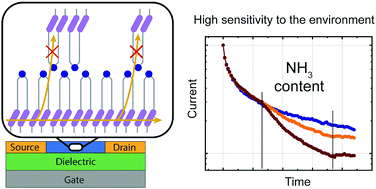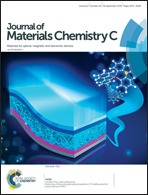Organosilicon dimer of BTBT as a perspective semiconductor material for toxic gas detection with monolayer organic field-effect transistors†
Abstract
Monolayer organic field effect transistors (OFETs) provide opportunity for ultrahigh sensitivity gas sensor applications due to a strong dependence of OFET key parameters on the environment. However, an impressive combination of both high sensitivity and instantaneous response of such gas sensors can be achieved only on low-defect dense monolayers with high electrical performance. Herein, we investigated monolayer thin film formation of recently developed benzothieno[3,2-b][1]benzothiophene (BTBT) organosilicon dimer D2-Und-BTBT-Hex by Langmuir–Blodgett, Langmuir–Schaefer and spin-coating methods. For all these techniques, the conditions of uniform low-defect monolayer formation were found. These monolayers were used for preparation of OFET devices, which demonstrated excellent electrical performance with a hole mobility up to 7 × 10−2 cm2 V−1 s−1, a threshold voltage around 0 V and an on–off ratio of 105 as well as long-term stability of half-year storage under ambient conditions. Preliminary investigations demonstrated that the monolayer OFETs give an instantaneous response to ammonia at low concentrations (down to 400 ppb). These findings show a great potential of BTBT-based OFETs for large-area sensing device application.



 Please wait while we load your content...
Please wait while we load your content...